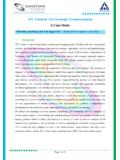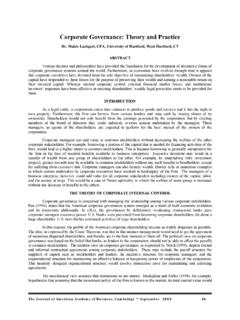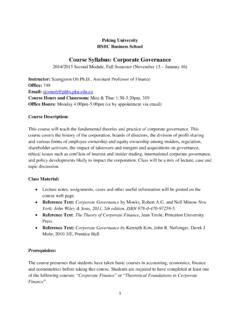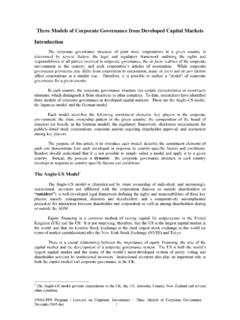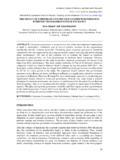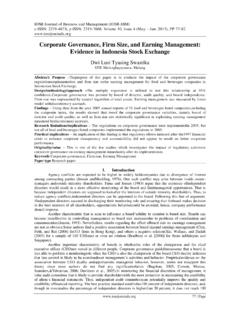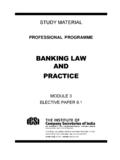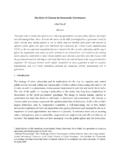Transcription of The Shareholder and Stakeholder Theories of …
1 ! The Shareholder and Stakeholder Theories of corporate Purpose By Dr. Daniel K. Saint and Mr. Aseem Nath Tripathi Introduction There is a continuing debate about what the purpose of the modern corporation should be. On the one hand, there are many scholars and practitioners who draw on an impressive body of theory and research to argue that the sole purpose of business should be the maximization of Shareholder wealth. On the other, there is a growing call by a broad base of constituency groups of business including customers, institutional shareholders , environmental and social activists, academics, government regulators, nongovernmental organizations, and businesses themselves for corporations to act responsibly toward the environment and toward all people affected by the corporation (The stakeholders).
2 Thus there are two contradicting and contrasting Theories of corporate purpose.! Shareholder value theory sets the purpose of the firm as the maximization of financial returns for shareholders . It is the dominant theory espoused and theory-in-use in business schools and in the vast majority of businesses in capitalist economies. Shareholder theory is then contrasted with Stakeholder theory the dominant theory espoused in the field of corporate social responsibility.! Stakeholder theory expresses the idea that business organizations are dependent upon stakeholders for success, and stakeholders have some stake in the organization.
3 Stakeholder theory suggests the purpose of the firm is to serve broader societal interests beyond economic value creation for shareholders alone. Though lively, this debate is typically carried out in either/or terms. Either the purpose of a corporation to maximize Shareholder value or it is to provide some larger service to society (Merton, 1976). Many researchers and leaders involved in business, however, desire a both/and "! ! ! world. They want to find ways to maximize both Shareholder value and societal contribution for all stakeholders.
4 Shareholder Value Theory Shareholder value theory is the dominant economic theory in use by business. Maximizing Shareholder wealth as the purpose of the firm is established in our laws, economic and financial theory, management practices, and language. Business schools hold Shareholder value theory as a central tenet. Nobel Laureate Milton Friedman (1970) strongly argues in favor of maximizing financial return for shareholders . His capitalistic perspective clearly considers the firm owned by and operated for the benefit of the shareholders .
5 He says there is one and only one social responsibility of business - to use its resources and engage in activities designed to increase its profits so long as it stays within the rules of the game, which is to say, engages in open and free competition without deception or fraud. '. Friedman's statements reflect three fundamental assumptions that lend support to the Shareholder view of the firm. The first is that the human, social, and environmental costs of doing business should be internalized only to the extent required by law.
6 All other costs should be externalized. The second is that self-interest as the prime human motivator. As such, people and organizations should and will act rationally in their own self-interest to maximize efficiency and value for society. The third is that the firm is fundamentally a nexus of contracts with primacy going to those contracts that have the greatest impact on the profitability of the firm. 1. Externalization of Costs According to this perspective, maximizing Shareholder value as the goal of the firm is the means to most efficiently achieve the best outcome for society (Jensen, 2001).
7 Taken literally, however, this theory holds that management should run the business to maximize cash flow to shareholders maximizing revenue, minimizing cost, and reducing risk. One way to reduce cost is by externalizing it through such means as polluting the environment. A way to increase revenue is #! ! ! to sell products that have a greater cost to society than is covered in the costs of the product, such as cigarettes or sport utility vehicles. In a contrast to Friedman (1970), Carroll (1979; 1999). developed a framework for legitimizing ethical and philanthropic considerations in management action.
8 ! Though Carroll's Stakeholder view of the firm is offered as an alternative to Friedman, both consider the economic aspect of business as the primary benefit for society. Carroll does go beyond Friedman in defining four legitimate roles of business. The following figure replicates Carroll's four responsibilities of corporate social responsibility as presented in the Wheelen and Hunger strategy textbook (p. 39). Carroll's 4 Responsibilities of Business As presented in Strategic Management and Business Policy (Wheelen & Hunger 2002).
9 Responsibilities of Business Social Responsibilities Discre- Economic Legal Ethical Tionary (Must Do) (Have to Do) (Should Do) (Might Do). Source: Adapted from Carroll, A. B. (1979). A three-dimensional conceptual model of corporate performance. Academy of Management Review, (October 1979), p. 499. 2. Self-Interest as the Prime Human Motivator The fundamental assumption of modern economic theory is a view of the individual self, acting rationally in self-interest (Ferraro et al., 2005). Amartya Sen (1977) wrote: "The first principle of Economics is that every agent is actuated only by self-interest" (p.)
10 317). The view of Friedman (1970) is traceable back to Adam Smith (1776) every person acting rationally in their own self- interest maximizes efficiency and value for society. Building on individual motivated by self- interest model, agency theory (Berle & Means, 1932) predicts a conflict between shareholders (principals) and managers (agents) in a publicly owned corporation. Unless appropriate $! ! ! governance structures are emplaced, managers will act in their own self-interest and not in the interests of the Shareholder (Jensen & Meckling, 1976).
